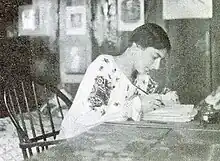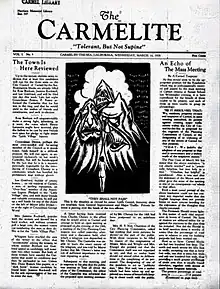Ella Winter | |
|---|---|
 Winter in her study in Carmel-by-the-Sea | |
| Born | Eleanora Sophie Wertheimer March 17, 1898 |
| Died | 5 August 1980 (aged 82) |
| Occupation(s) | Journalist and activist |
| Spouses | |
| Children | 3 |
Ella Winter Stewart (March 17, 1898 – August 5, 1980) was an Australian-British journalist and activist, and champion of migrant farm workers. She was married to Hollywood screenwriter Donald Ogden Stewart.[1]
Early life
Ella was born Eleanora Sophie Wertheimer in Nürnberg, Germany in 1898. Her parents were Freda Lust and Adolph Wertheimer of Nürnberg, who lived in London, Melbourne, Australia, and again in London, when they changed their name to Winter (around 1910).
In 1924 she married Lincoln Steffens after which she then had a son and moved to the largest art colony on the Pacific Coast, Carmel-by-the-Sea, California. Their children Peter, Rosa, and Eleanora (Ella) were born in Melbourne. Fredric Wertham was a relative. She studied at the London School of Economics in England.[1]
Career
Ella wrote on various topics. She and her family were also involved in controversial national campaigns, including the Scottsboro Boys Defense Fund which sought to free nine black men who were still incarcerated after the Supreme Court of the United States reversed their convictions for rape twice.[2][3][4]
She met the U.S. journalist and muckraker Lincoln Steffens at the Versailles Conference, where she was secretary to US Supreme Court Justice Felix Frankfurter. Winter and Steffens married in 1924. They moved to Italy, where their son, Peter, was born in San Remo. Two years later, they moved to the largest art colony on the Pacific Coast, Carmel-by-the-Sea, California. Where their social circle included photographer Edward Weston, poet Robinson Jeffers, philosopher/mythologist Joseph Campbell, nutritionist/author Adelle Davis, short story writer/poet Clark Ashton Smith, marine biologist/ecologist Ed Ricketts, Nobel prize winner Sinclair Lewis, and novelists John Steinbeck and Henry Miller.[5]
Ella divorced Steffens on June 21, 1929.[6] Lincoln Steffens died on August 9, 1936, of a heart condition in Carmel.[7]
Ella loved publicity and when two Carmel reactionaries, artist William Silva and writer/editor Perry Newberry, tried to ban her local chapter of the communist-affiliated John Reed Club as well as her "socialist reading room", she made sure that the press as far away as Los Angeles was apprised of the violation of her civil rights.[8][9] The Steffens's also joined controversial national campaigns, including the Scottsboro Boys Defense Fund which sought to free nine black men who were still incarcerated after the Supreme Court of the United States twice reversed their convictions for rape.[2][3][4]
The Carmelite

The Carmelite, a weekly newspaper, was published in Carmel-by-the-Sea from 1928 to 1932. Its inception was fueled by the desire to provide an alternative to the town's conventional publication, the Carmel Pine Cone. Spearheaded by Ella Winter and Steffens in 1928, The Carmelite swiftly gained recognition for its unique perspective on art, establishing itself as one of California's most contentious periodicals. Within its pages, Ella fearlessly explored an array of subjects, captivating readers with her diverse writings.[5]
The Carmel Colony was sharply divided between conservative and liberal factions; the latter quickly coalesced around the Steffens's, who publicly debated the most controversial topics. The Irish poet and folklorist Ella Young, as well as the local press, described the relaxed social intercourse in this counterculture world.[10][11]
With contributions by numerous leftist literati, including Jeffers, Martin Flavin, Lewis and the Steffens's, along with theater, dance and art reviews by feminist artists such as Alberta Spratt, Jennie V. Cannon, and Roberta Balfour, The Carmelite became one of California’s most controversial publications.[5]
Pauline Gibling Schindler, an educator, editor, and advocate of the arts, took on the role of editor at The Carmelite. During her tenure, tensions arose between her and fellow editor Steffens, leading to clashes behind the scenes.[12][13][14]
Its illustrations ranged from Weston’s enigmatic photos to the "anarchist" prints of James Blanding Sloan. The Steffens's also arranged for public exhibits of Europe’s most avant-garde art, including Dada, Surrealism and the paintings of Paul Klee. Ella wrote on various topics and once reported on the very unusual meeting between the popular Modernist artists John O’Shea and Frederick O’Brien.[15] The Steffens' support of the art community extended to their own home where they entertained local painters and offered to display their work.[16]
The Carmelite persisted for an additional three years before reaching its conclusion. In the December 29, 1932 issue, a small boxed notice graced the front page. Penned by the editor J.A. Coughlin, the announcement disclosed that the paper was up for sale and would cease publication. It solemnly declared, "As far as I am concerned, The Carmelite now passes from the scene," marking the final curtain call for the newspaper.[17]
Publications
A close associate with the Communist Party USA and strong supporter of the Soviet Union under Stalin, she wrote her first book, Red Virtue, after visiting the Soviet Union in 1932.[18]
She returned to the Soviet Union in 1944 and published I Saw the Russian People the following year.[18] In her autobiography, And Not to Yield published in 1963, she affirmed her support for the Soviets while admitting that she had concealed negative aspects of the murderous regime.[19] At the time, she told a friend that she was not part of the "'God that failed' brigade and did not want her book to be of advantage to that group".[19]
In 1939, Ella married the screenwriter and humorist Donald Ogden Stewart and became stepmother to his sons, Donald and Ames. They lived in California and then in Hampstead, London.
Death
Ella died of a stroke on 5 August 1980 at her home in Hampstead, London. She was 82 years old.[20][1]
Bibliography
- Red Virtue: Human Relations in the New Russia. Harcourt, Brace & Company, New York 1933
- Ella Winter, Granville Hicks (eds.): The Letters of Lincoln Steffens. Harcourt, Brace & Company, New York 1938
- I Saw the Russian People. Little, Brown and Company, Boston 1945
- Ella Winter, Herbert Shapiro (eds.): The World of Lincoln Steffens. 1962
- And Not to Yield: An Autobiography. Harcourt, Brace & World, New York 1963
Notes
- 1 2 3 "Ella Winter Stewart". Oakland Tribune. Oakland, California. 5 August 1980. Retrieved 10 July 2023.
- 1 2 The San Francisco News, 24 February 1934, p. 11.
- 1 2 Carmel Pine Cone, 23 February 1934, p. 5.
- 1 2 The Oakland Tribune, 24 February 1934, p. 9.
- 1 2 3 Edwards, Robert W. (2012). "Chapter Two – Western Frontiers: Birth of the Carmel Art Colony (1896-1909)". Jennie V. Cannon: The Untold History of the Carmel and Berkeley Art Colonies (PDF). Oakland, California. p. 39. ISBN 978-1467545679. Retrieved 7 April 2023.
{{cite book}}:|work=ignored (help)CS1 maint: location missing publisher (link) - ↑ "Lincoln Steffens Wins Divorced by Wife". The San Francisco Examiner. San Francisco, California. 21 June 1929. Retrieved 10 July 2023.
- ↑ "Lincoln Steffens, First Muckraker Dies At 70". Associated Press. 10 August 1936. Retrieved 10 May 2011.
- ↑ The Carmelite, 14 April 1932, p. 9.
- ↑ Los Angeles Times, 22 April 1932, p. I-2.
- ↑ Young, Ella (1945). Flowering Dusk, Things Remembered Accurately and Inaccurately. New York, NY: Longmans, Green & Co. pp. 297–301.
- ↑ Carmel Pine Cone, 1 November 1935, p. 6; 14 February 1936, p.11.
- ↑ Hartshorn, Peter (2011). I Have Seen the Future: A Life of Lincoln Steffens. Catapult. ISBN 978-1582436470.
{{cite book}}:|work=ignored (help) - ↑ "Pauline Schindler and The Carmelite Two Meteors in Carmel's Orbit" (PDF). Carmel Residents Association Newsletter. November–December 2010. Retrieved 28 June 2023.
- ↑ "Dispute Over Carmel Paper Amuses Coast". Daily Capital Journal. 26 February 1929. p. 3. Retrieved 28 June 2023.
- ↑ The Carmelite, 3 April 1929, p. 3.
- ↑ Carmel Pine Cone, 19 April 1929, p. 14.
- ↑ Richard Flower (2014). "Pauline Schindler & The Carmelite: Two Meteors in Carmel's Orbit". Stories of Old Carmel: A Centennial Tribute From The Carmel Residents Association. Carmel-by-the-Sea, California. pp. 102–103.
{{cite book}}:|work=ignored (help)CS1 maint: location missing publisher (link) - 1 2 Ros Pesman. "'Red Virtue': Ella Winter and the Soviet Union." Political Tourists: Travellers from Australia to the Soviet Union in the 1920s–1940s. Sheila Fitzpatrick and Carolyn Rasmussen, eds. Melbourne University Press, 2008. pp.102–104. ISBN 9780522855333
- 1 2 Ros Pesman. "'Red Virtue': Ella Winter and the Soviet Union." Political Tourists: Travellers from Australia to the Soviet Union in the 1920s–1940s. Sheila Fitzpatrick and Carolyn Rasmussen, eds. Melbourne University Press, 2008. pp.116. ISBN 9780522855333
- ↑ Cook, Joan (5 August 1980). "Ella Winter Stewart, Journalist and Widow Of Donald O. Stewart; Was War Correspondent Back After 17 Years". The New York Times. Retrieved 18 April 2008.
External links
- Donald Ogden Stewart and Ella Winter Papers. Yale Collection of American Literature, Beinecke Rare Book and Manuscript Library.
- Lying for Truth: Münzenberg & the Comintern (Stephen Koch)